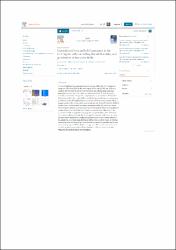| dc.contributor.author | Sayrac, Muhammed | |
| dc.contributor.author | Kolomenskii, Alexandre A. | |
| dc.contributor.author | Dong, Jian | |
| dc.contributor.author | Schuessler, Hans A. | |
| dc.date.accessioned | 2022-05-09T11:24:12Z | |
| dc.date.available | 2022-05-09T11:24:12Z | |
| dc.date.issued | 2021 | tr |
| dc.identifier.citation | Muhammed Sayrac, Alexandre A. Kolomenskii, Jian Dong, Hans A. Schuessler,
Generation of even and odd harmonics in the XUV region with controlling the relative delay and polarization of two-color fields,
Optik, Volume 226, Part 1, 2021, 165966,
https://doi.org/10.1016/j.ijleo.2020.165966. | tr |
| dc.identifier.uri | https://www.sciencedirect.com/science/article/pii/S0030402620317800 | |
| dc.identifier.uri | https://hdl.handle.net/20.500.12418/12680 | |
| dc.description.abstract | We report high harmonic generation in the extreme ultraviolet (XUV) region by using two-color
laser fields at the wavelengths of 800 nm and 400 nm. With a Ti: sapphire femtosecond laser at a
10 Hz repetition rate efficient high harmonic generation was obtained in an argon gas medium
with the IR field (ω) and its second harmonic (2ω) with parallel and perpendicular polarizations.
The relative delay between the pulses is controlled via a Michelson interferometer arrangement.
In addition to the odd high harmonic spectrum with frequencies (2n+1)ω, where n - integer
number, also even spectral components 2nω are obtained, when the fields of the two colors are
temporally overlapped and interact with the argon gas. Due to this overlap, the yield of odd
harmonics can be increased as well. The calculations of electron trajectories within the semiclassical approach show differences in the action of the fields with parallel and perpendicular
polarizations. For the former, there exist broad time intervals for returning electrons, and in the
latter case there are only narrow intervals for possible solutions for each of the electron returns to
the parent ion for a fixed phase difference between the ω and 2ω fields. By varying the relative
delay between the two laser fields it is possible to spectrally enrich and enhance the produced
XUV radiation or suppress it. The conclusions of the semi-classical approach were confirmed by
calculations of the harmonic intensities within the strong field dipole approximation. | tr |
| dc.description.sponsorship | Robert A. Welch Foundation, grant No. A1546. | tr |
| dc.language.iso | eng | tr |
| dc.publisher | Elsevier | tr |
| dc.relation.isversionof | 10.1016/j.ijleo.2020.165966 | tr |
| dc.rights | info:eu-repo/semantics/restrictedAccess | tr |
| dc.subject | High harmonic generation Two-color excitation XUV radiation spectroscopy Even and odd harmonics Pulses with controlled polarization Electron motion in two-color fields | tr |
| dc.title | Generation of even and odd harmonics in the XUV region with controlling the relative delay and polarization of two-color fields | tr |
| dc.type | article | tr |
| dc.relation.journal | Optik | tr |
| dc.contributor.department | Mühendislik Fakültesi | tr |
| dc.identifier.volume | 226 | tr |
| dc.identifier.issue | 1 | tr |
| dc.relation.publicationcategory | Uluslararası Editör Denetimli Dergide Makale | tr |















